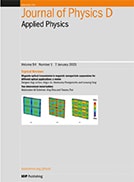Please enter the e-mail address you used to register to reset your password
Thank you for registering with Physics World
If you’d like to change your details at any time, please visit My account
Join the audience for a live webinar at 11 a.m. BST on 19 September 2022, sponsored by the IOP Publishing journal, Journal of Physics D: Applied Physics, to explore the latest developments in magneto-optics science and technology
Want to take part in this webinar?
Magneto-optical effects (magnetically induced changes in light intensity or polarization upon reflection from or transmission through a magnetic sample) were discovered more than a century and a half ago. Initially they played a crucially relevant role in unveiling the fundamentals of electromagnetism and quantum mechanics. But since then, there has been an enormous expansion of magneto-optical measurement techniques and applications that continues to this day.
Based on the forthcoming ‘The 2022 Magneto-Optics Roadmap’, this webinar will comprise three of the leading researchers highlighting some the cutting-edge research currently being conducted in the field. This will be followed by a panel discussion that will attempt to outline the future direction of research and what challenges remain in this exciting area. All speakers and panellists are authors on the aforementioned roadmap.
Want to take part in this webinar?
Chairs
Andreas Berger has, since 2007, been the research director of CIC nanoGUNE in San Sebastian, Spain. He received his PhD in 1993 from the Technical University Aachen for his work on surface magnetism. Subsequently, he worked at the University of California and Argonne National Laboratory on topics related to thin film magnetism and magneto-optics.
Paolo Vavassori is an Ikerbasque research professor and co-leader of the Nanomagnetism Group at CIC nanoGUNE (San Sebastian, Spain). He has more than 20 years of experience in the field of magneto-optics and magnetism at the nanoscale. The current focus of his research encompasses the study of light-matter interaction at the nanoscale, magnetoplasmonic nanostructured metamaterials for nanophotonic and sensing applications, and the physics of geometrically frustrated networks of magnetic nanostructures.
Speakers
Pietro Gambardella obtained his PhD from the Ecole Polytechnique Fédérale de Lausanne (EPFL), Switzerland, with a thesis on the growth, electronic, and magnetic properties of metallic nanowires. Since 2013, he has been a full professor of magnetism and interface physics at ETH Zurich. His research interests are in the areas of magnetism, spintronics, and novel techniques to probe solid-state interfaces.
Claire Donnelly completed her PhD in 2017 for her work on 3D systems. After her postdoc at ETH Zurich, she moved to the University of Cambridge and the Cavendish Laboratory where she was awarded the L’Oreal For Women in Science Fellowship, and the European Magnetism Association Young Scientist Award. Since September 2021, she is a Lise Meitner group leader of Spin3D at the Max Planck Institute for Chemical Physics of Solids.
Markus Münzenberg completed his PhD in 2000 and now leads a research group at the University of Greifswald as a professor of interface and surface physics. In recent years, he has opened new research fields in ultrafast magnetism, THz spintronics and novel THz emitters, and contributed to the emerging fields of magnonics and spin caloritronics. Recently, he joined work on topological spin-textures (skyrmions) and bio-nanomechanics 3D laserlithography for medical applications.
About this journal

Journal of Physics D: Applied Physics is an international journal publishing high-quality work concerned with all aspects of applied physics research, from biophysics, magnetism, plasmas, semiconductors, energy materials and devices to the structure and properties of matter.
Editor-in-chief: Huiyun Liu University College London – UCL, UK
This issue explores how researchers in so many areas of materials science are working towards a more sustainable society.
Physics World represents a key part of IOP Publishing’s mission to communicate world-class research and innovation to the widest possible audience. The website forms part of the Physics World portfolio, a collection of online, digital and print information services for the global scientific community.